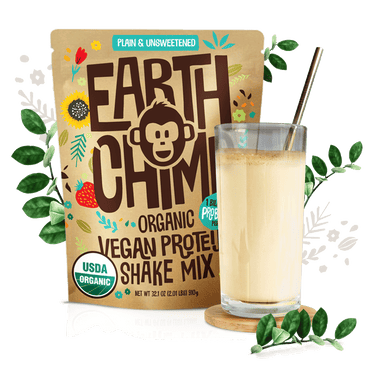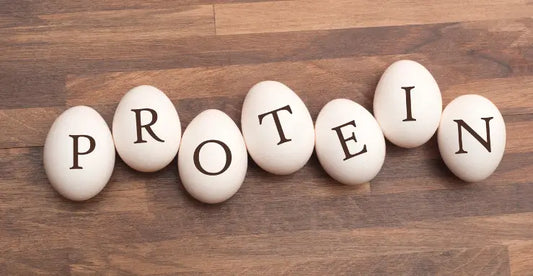Protein powder is incredibly versatile, but what you mix it with can make all the difference. From quick shakes and smoothie bowls to overnight oats or high-protein snacks, the right mix-ins can transform both the taste and the nutrition of your daily protein routine.
Sure, water and milk are go-to choices for blending, but they’re classic go-to choices for blending. Beyond that, there’s a whole world of delicious, functional ingredients to explore — from fruits and nut butters to teas, grains, and yogurt. Whether you're aiming for weight loss, building muscle mass, or looking for a natural protein boost, there’s something for every goal and palate.
In this guide, we’ll break down the best ingredients to pair with protein powder — from liquids and fruits to nut butters, fiber-rich add-ins, and creative superfoods. We’ll also share tips on how to match your mix with your goals and avoid common shake mistakes.
Let’s jump in and help you build your perfect protein-powered combo — one that supports what your body needs and actually tastes great.
Things to Consider When Deciding What to Mix with Protein Powder
Mixing protein powder with the right ingredients can make a big difference in how your shake tastes, how it feels, and how well it supports your health goals. While liquids are still the base of most shakes, there are plenty of other ingredients you can add, like fruits, oats, seeds, or yogurt, to boost flavor, texture, and nutrition. Here are a few things to think about when choosing what to mix protein powder with:
Your Personal Goals and Nutrition Needs
What you mix protein powder with should reflect what you're trying to achieve. If you're focused on weight loss, stick with low-calorie bases like water or unsweetened almond milk, and add fiber-rich ingredients like chia seeds or leafy greens to help keep you full. If you're trying to build muscle or gain weight, higher-calorie mix-ins like whole milk, oats, bananas, or nut butters can add energy and extra nutrients to support recovery and growth.
For general wellness or post-workout recovery, combining protein powder with antioxidant-rich fruits or probiotic-rich yogurt can offer added benefits.
Your Dietary Preferences and Restrictions
Everyone’s dietary needs are different. If you're vegan, dairy-free, or managing allergies, plant-based milks, dairy-free yogurts, or seeds can help meet your protein requirements without traditional dairy or nuts.
If you’re gluten-free, go for certified gluten-free oats. One of the benefits of using protein powder is how easy it is to add natural mix-ins that match your eating style.
Taste and Texture Preferences
A shake that matches your flavor and texture preferences is one you'll actually enjoy. For a rich and creamy feel, bananas, yogurt, or oat milk do the trick. Prefer something lighter? Water, coconut water, or tropical fruits like pineapple can make your shake more refreshing.
You can also experiment with textures — adding granola or a spoonful of nut butter brings crunch and depth without sacrificing that tasty protein experience.
Finding what works best depends on the best taste you enjoy and the feel you want — so don’t be afraid to mix and match.
Top Mix-In Ideas for Protein Powder: Easy Drinks to Tasty Blends

Best Liquid Bases for Protein Powder
-
Water: The cleanest, simplest option. Water is calorie-free and lets the flavor of your protein powder stand out. Add crushed ice or a pinch of cinnamon to keep it refreshing without changing the macros.
-
Milk: Dairy milk is rich and creamy, offering protein, calcium, and vitamin D. For a lactose-free or vegan alternative, plant-based options like almond, soy, or cashew milk work just as well — some even add extra nutrients or protein.
-
Juice: Fruit juices bring in natural sweetness and flavor, making them great for masking earthy-tasting powders like pea or hemp. Orange, apple, pineapple, cranberry, and pomegranate juices all pair well with vanilla or tropical protein blends — just keep an eye on sugar content.
-
Coconut Water: Light, subtly sweet, and packed with electrolytes, coconut water is a refreshing base after a tough workout. It pairs especially well with tropical protein flavors like mango, pineapple, or coconut.
Fruits & Veggies That Blend Beautifully
Adding fruits and vegetables to your protein shake is an easy way to boost flavor, texture, and nutrition. From creamy bananas to vibrant greens, these mix-ins can turn a basic shake into a nutrient-dense meal or snack.
-
Bananas: A smoothie staple for a reason — bananas bring natural sweetness and a thick, creamy texture. They pair well with chocolate, vanilla, or peanut butter-based protein powders.
-
Berries: Berries like blueberries, strawberries, and raspberries are packed with antioxidants and vitamins, adding a refreshing tang and bold flavor to any protein shake.
-
Mango: This tropical fruit delivers juicy sweetness and a boost of vitamin C. It’s a perfect match for coconut, vanilla, or plant-based protein powders.
-
Avocado: While technically a fruit, avocado adds a dose of healthy fats and a luxuriously creamy texture without overpowering the shake’s flavor.
-
Kiwi: With a tart-sweet flavor and plenty of vitamin C, kiwi brings a bright, zesty twist to your blend — great with vanilla or citrus-inspired shakes.
-
Spinach: Mild in taste and rich in nutrients, spinach blends in seamlessly and works well with just about any flavor of protein powder.
-
Kale: A bit earthier than spinach but just as nutritious. Kale adds fiber and antioxidants and balances best with sweet fruits or creamy mix-ins.
-
Carrots: Naturally sweet and loaded with beta-carotene, carrots are a colorful addition that works surprisingly well in spiced or citrus protein shakes.
-
Beets: Earthy, slightly sweet, and rich in antioxidants, beets pair well with berries or chocolate-flavored protein powder for a unique flavor combo.
-
Cucumber: Light and hydrating, cucumber adds a refreshing twist to your shake — especially nice in green or tropical blends.
Nut Butters & Healthy Fats
Nut butters are a delicious way to add healthy fats, flavor, and extra creaminess to your protein shakes. They make your blend more satisfying and can support energy levels, muscle recovery, and heart health — especially when you're using them post-workout or as a meal replacement.
-
Peanut Butter: A classic mix-in that brings bold flavor, healthy fats, and a touch of extra protein. Peanut butter blends beautifully with chocolate or banana-based shakes and is budget-friendly, too.
-
Almond Butter: A great option for those avoiding peanuts, almond butter has a smooth texture and a subtle, slightly sweet flavor. It's packed with monounsaturated fats and works well in vanilla or berry protein shakes.
-
Cashew Butter: Known for its rich, buttery texture, cashew butter adds creaminess and a mild nutty flavor. It pairs nicely with cinnamon, vanilla, or spiced protein blends for a dessert-like finish.
Grains, Oats & Fiber-Rich Add-Ins
Want to turn your protein shake into a full-on meal? Fiber-rich mix-ins like oats, seeds, and grains add staying power, thickness, and subtle texture while supporting digestion and blood sugar balance.
-
Rolled Oats: Perfect for thicker shakes and smoothie bowls, oats provide slow-digesting carbs and fiber. They blend best when soaked or pre-blended with your liquid base.
-
Chia Seeds: Tiny but mighty, chia seeds absorb liquid and create a gel-like texture. They’re a great source of omega-3s, fiber, and plant-based protein.
-
Flaxseeds: Ground flaxseeds add a mild nutty flavor, plus fiber and heart-healthy fats. Use them in small amounts to avoid grittiness.
Yogurts & Creamy Bases
Yogurt-based mix-ins can take your protein shake to a new level of creaminess while adding gut-friendly probiotics and extra protein. They’re great for creating a smoothie that feels more like a satisfying snack or meal.
-
Greek Yogurt: Thick, protein-packed, and slightly tangy, Greek yogurt gives your shake richness and a pleasant creaminess. Choose plain, unsweetened for better control over sweetness.
-
Kefir: This fermented drinkable yogurt is a probiotic powerhouse and blends easily into shakes. It’s especially useful for digestion and works well with fruity flavors.
Natural Sweeteners & Flavor Boosters
These ingredients bring out the best in your protein powder by enhancing sweetness and depth — naturally and deliciously.
-
Dates: Soft, naturally sweet, and fiber-rich, dates blend well into chocolate, peanut butter, or caramel shakes.
-
Cinnamon: A warming spice that complements vanilla, banana, and nut-based protein blends. It adds flavor without extra calories.
-
Honey or Maple Syrup: Natural liquid sweeteners that dissolve easily and give your shake a smooth, comforting sweetness.
-
Cocoa Powder: Unsweetened cocoa powder is a simple way to deepen the flavor of chocolate shakes or turn a vanilla base into a chocolatey treat.
Uncommon Protein Powder Mix-Ins Worth Trying
Beyond the basics, there are plenty of creative mix-ins that can elevate your protein shake — whether you’re after more energy, better flavor, or an extra nutritional edge. These ingredients include both liquids and solids, offering texture, taste, and function all in one.
Energizing Add-Ins
These mix-ins are perfect for boosting your energy levels and adding a flavorful kick — ideal for mornings, pre-workout shakes, or a midday recharge.
-
Coffee: Blended into shakes for a creamy, caffeinated “proffee.” Try it with chocolate or caramel protein for a rich, bold flavor.
-
Green Tea: Brewed and chilled, green tea offers a subtle earthy note and antioxidants. Works well in light, fruit-based shakes.
-
Matcha Powder: A finely ground green tea powder packed with antioxidants and natural caffeine. It adds a vibrant color and energizing lift.
-
Dark Chocolate Chips or Cacao Nibs: These crunchy mix-ins add texture and a bittersweet chocolate bite — perfect for dessert-inspired shakes.
Mix-In Combos Based on Goals
Choosing what to mix with your protein powder can be even more effective when you match your ingredients to your specific health goals. Whether you're looking to shed pounds, build strength, or simply feel more energized, here are some smart mix-in combos to guide your blend:
-
For Weight Loss:
Keep it light, filling, and fiber-rich to help you stay satisfied without the extra calories.
Try: Water + spinach + chia seeds + cinnamon
A refreshing, low-calorie combo that supports fullness and digestion.
-
For Muscle Gain:
Opt for calorie-dense and nutrient-packed ingredients that help with recovery and muscle growth.
Try: Whole milk + banana + peanut butter + oats
Creamy, satisfying, and full of fuel for strength-building.
-
For Digestion:
Use gut-friendly and fiber-rich mix-ins to support healthy digestion.
Try: Kefir + mixed berries + ground flaxseed
A tangy, probiotic-rich combo that’s easy on the stomach and high in fiber.
-
For Energy:
Go for natural stimulants and complex carbs to stay focused and fuel your day.
Try: Coffee + matcha powder + almond butter + dates
A smooth, energizing blend with a little kick and slow-burning fuel.
Common Mistakes to Avoid

Even the best mix-ins can fall short if the base — or the balance — isn’t right. Here are a few common mistakes to watch out for when mixing protein powder into your daily routine:
1. Overdoing the Sweeteners
Adding too many sweeteners — even natural ones like honey, maple syrup, or dates — can turn your healthy shake into a sugar bomb. Aim for balance, especially if you're using fruit or flavored protein powders that already contain sweetness.
2. Forgetting to Balance Protein with Fiber or Fat
Protein is important, but combining it with fiber (like chia or flaxseed) or healthy fats (like nut butters or avocado) helps keep you full longer and supports stable energy levels.
3. Not Checking the Labels on Store-Bought Liquids
Many plant-based milks and fruit juices come with added sugars, thickeners, or artificial ingredients. Always go for unsweetened, clean-label options whenever possible.
4. Overloading with Too Many Ingredients
It’s easy to go overboard, especially when everything sounds healthy. But too many mix-ins can make your shake overly thick, high in calories, or hard to digest. Stick to 3–5 purposeful ingredients for the best results.
5. Choosing Low-Quality Protein Powder
Not all protein powders are created equal. Some contain artificial flavors, gums, or low-quality fillers that can leave you bloated or unsatisfied. Choosing a clean, plant-based option made with real ingredients, like our vegan protein powder, can make a big difference in both taste and how you feel after.
How to Pick the Right Protein Powder for Your Mix-Ins
Your mix-in choices matter — but so does the protein powder itself. Choosing the right type can make all the difference in taste, texture, digestibility, and how well it supports your nutrition goals.
Flavor Compatibility:
Some protein powders have stronger or more distinct flavors than others. For example, pea or hemp protein often has an earthy taste, while rice protein is milder and slightly nutty. These flavor notes can be balanced — or enhanced — with the right mix-ins. Chocolate hemp protein might shine with banana and peanut butter, while vanilla rice protein pairs well with almond milk and berries.
Texture Preferences:
If you prefer creamy, smooth blends, go for protein powders that mix well with minimal grittiness. Plant-based options like pea and rice can vary in texture depending on quality and formulation, but when blended with ingredients like oats, banana, or almond butter, they create a rich, satisfying shake.
Nutritional Goals:
Whether you're managing your weight, building muscle, or supporting overall wellness, your protein powder should match your goals. Some plant-based powders are low in carbs and calories, making them perfect for weight management. Others include added superfoods or fiber to support digestion and recovery.
Ingredient Quality:
Not all protein powders are created equal. Look for options with real, recognizable ingredients and no artificial fillers, gums, or added sugars. A clean, plant-based protein, like our vegan blend made with organic ingredients, can give you all the nutritional benefits without compromising on taste or digestion.
Wrapping Up: Finding the Best Mix for Your Protein Powder

There’s no one-size-fits-all when it comes to mixing protein powder. The “best” combo is the one that fits your goals, tastes good, and works for your lifestyle. Whether you're blending it into a quick shake with water or milk, building a smoothie bowl with fruits and nut butters, or stirring it into oats or yogurt — the possibilities are endless.
Just remember: quality matters. The ingredients you mix in are important, but so is the protein powder at the heart of it all. That’s why we love our 100% organic, plant-based protein powder — made from pea, pumpkin, sunflower, and coconut proteins, and completely free from added sugars, dairy, gluten, gums, and artificial flavors. Plus, it includes gut-friendly probiotics for a little extra feel-good support.
No matter how you choose to mix it, our vegan protein is made to keep up with your creativity — and your goals. So grab your blender, get inspired, and enjoy finding your perfect protein combo.
Frequently Asked Questions: Protein Powder Mix-Ins
What If I'm Lactose Intolerant or Vegan?
If you can't have lactose, are allergic to dairy, or follow a vegan diet, plant-based milks like almond, soy, oat, and coconut milk are great alternatives. They offer a creamy texture similar to dairy milk. Choose unsweetened and fortified options for added calcium and less sugar, and fat.
How Can I Make My Protein Smoothie More Refreshing?
Coconut water is an excellent mixer for protein shakes, especially after intense workouts. It helps replace lost fluids and electrolytes like sodium and potassium. Unsweetened coconut water with minimal processing is naturally rich in electrolytes and minerals, making it perfect for rehydrating post-workout.
What's a Good Liquid for a Unique Protein Shake Flavor?
Low-sodium tomato juice, beet juice, and carrot juice can add extra nutrition and interesting flavors to your protein smoothies. Chilled green tea, chamomile tea, mint tea, and ginger tea are also fun options that provide antioxidants and various health benefits when mixed with protein powder.
How Can I Make My Protein Shake Less Thick?
Regular water helps thin out thick smoothies, while naturally carbonated mineral water gives a fizzy texture and provides added calcium and magnesium for bone health. Just be careful with heavily carbonated varieties to avoid excessive foaming.
What's the Best Way to Mix Protein Powder Into My Shake?
Using a blender to make protein smoothies ensures a clump-free consistency. If you don't have a blender, you can use a shaker bottle or mix the powder into the liquid gradually with a spoon or whisk to help break up any clumps.
References:
- https://www.healthdigest.com/826815/what-liquids-should-you-mix-protein-powder-with/
- https://www.wickedprotein.com/blogs/nutrition/what-to-mix-protein-powder-with-10-ideas
- https://uniconutrition.com/blog/fitness-hacks/the-best-liquids-to-mix-your-protein-powder-into
- https://www.trufoojuicebar.co.uk/single-post/5-best-liquid-bases-for-protein-smoothies#google_vignette
- https://www.transparentlabs.com/blogs/all/what-to-mix-protein-powder-with
- https://pubmed.ncbi.nlm.nih.gov/26228533/
- https://www.ncbi.nlm.nih.gov/pmc/articles/PMC6472148/
- https://www.ncbi.nlm.nih.gov/pmc/articles/PMC6155401/
- https://www.healthline.com/health/kefir-vs-yogurt
Disclaimer:
This statement has not been evaluated by the Food and Drug Administration. This product is not intended to diagnose, treat, cure, or prevent any disease.















